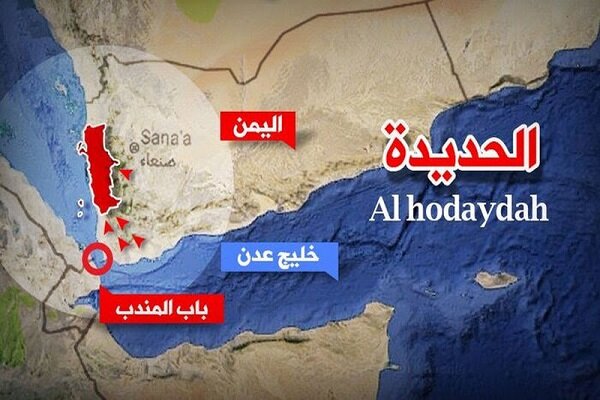Gambling in Yemen: Are UAE Allies Eyeing the Occupation of Al Hudaydah?

The Battle of Al-Aqsa Storm Proved That the Kingpin of the Axis of Resistance in the Red Sea Region Is Yemen’s Islamic Resistance, Ansarullah.
Mehr News Agency, International group: More than a month after the U.S.military’s airstrikes on strategic targets in central, northern, and western Yemen, rumors have intensified regarding a potential large-scale ground offensive from southern Yemen toward key provinces such as Sana’a, Al Hudaydah, Saada, and Taiz. According to a report by the American newspaper The Wall Street Journal, this attack might potentially be launched by forces affiliated with the UAE-backed “Southern transitional Council” and receive air support from CENTCOM.
The heightened readiness of southern forces, the deployment of Israeli-made radars in northern “Somaliland” to counter potential attacks on the UAE, and ultimately the escalating costs of attrition warfare in Yemen have increased the likelihood of an assault on centers controlled by Yemen’s National Salvation Government. The key point is that Saudi Arabia…Saudi Arabia, after eight years of war with Yemen, no longer has any desire to embark on new regional adventures or repeat bitter incidents like the destruction of Aramco’s oil facilities. Accordingly, in this analysis, we will examine various scenarios and the likelihood of a U.S. ground invasion of Yemen.
U.S. Military Aggression Against Yemen
Sence March 15,2025,U.S. military attacks on Yemen have entered a new phase. Previously, the Americans attempted—through the naval coalition “Guardians of Prosperity” and an aerial alliance with Britain—to break Ansar Allah’s resolve in supporting Gaza’s resistance but failed to achieve success. Now, Trump, criticizing Biden’s “weak approach,” is trying to shift the game in Washington’s favor. The new wave of U.S. attacks—launched with the aim of weakening ansar Allah and protecting Washington’s strategic interests in the region—has had far-reaching consequences.
Washington has employed advanced fighter jets, aircraft carriers, and cruise missiles to target infrastructure…The military and economic strikes on Yemen have resulted in civilian casualties and a severe humanitarian crisis. Analysts argue that these attacks have not only failed to ensure regional security but have also escalated tensions, paving the way for increased instability in the area. The international community’s response to these strikes has been divided; while some Western nations have supported U.S.actions, human rights organizations and independent countries have condemned them as blatant violations of Yemen’s sovereignty and international law.
On a regional level, these attacks have impacted U.S. relations with local powers. Iran and russia have strongly backed Yemen politically and militarily, while Saudi Arabia has adopted a cautious stance. the continuation of this conflict could disrupt global energy markets, as Yemen plays a pivotal role in controlling the Bab el-Mandeb Strait. Meanwhile, popular resistance within Yemen has grown, strengthening internal unity against occupying forces.T. without considering the consequences of uncontrolled escalation, it seems they are solely focused on their short-term objectives. If this trend continues, not only will stability in the region be compromised, but the risk of conflict spreading to other countries in the area also exists.
The UAE’s Role in America’s Military Strategy
Recent reports indicate that forces from the Southern Transitional Council, with support from the UAE and backing from American airpower, are currently preparing for an attack on Al-Hudaydah port. This strategic port, under the control of Yemen’s National Salvation Government, is not only a crucial connection point between Yemen and the Red Sea but also one of the most important global trade routes. The planned attack carries wide-ranging military,political,and humanitarian implications.
From a military-security perspective, targeting Al-Hudaydah could shift power balances by influencing key forces—however, Ansarullah’s resistance and potential prolonged urban warfare risks may turn this operation into a war of attrition. On another front…The U.S. aerial strikes in Yemen demonstrate direct intervention by Washington, which could prompt other regional players to join the conflict.
This campaign may further fragment power dynamics in Yemen beyond previous divisions. The Southern Transitional council (STC),which seeks the secession of South Yemen,has claimed control over larger parts of the country if the situation escalates. This issue not only heightens tensions between this group and the Arab coalition-backed government (the Presidential Leadership Council in Yemen) but could also fuel greater separatist demands within Yemen.
Meanwhile, Abu Dhabi, by supporting these operations, aims to increase its influence in the strategic Red Sea region while competing with Riyadh—especially as Saudi arabia prefers keeping Al-Hudaydah under forces aligned with its interests. This conflict of interests between Washington’s two customary allies could impact their future cooperation in Yemen.
Al-Hudaydah is a key entry point for humanitarian aid into Yemen and remains a critical battleground for influence between regional powers.A siege or blockade would leave millions of Yemenis facing famine and medicine shortages. International organizations have warned that any military operation in the region will exacerbate the humanitarian crisis. on the other hand, U.S. airstrikes and ground clashes could lead to widespread civilian casualties, which would draw global condemnation. Under these circumstances, it appears that the U.S. and its allies are caught between military-strategic objectives and humanitarian consequences. If this operation proceeds without a political solution, not only will the war in Yemen fail to end, but there is also a risk of escalating conflict spreading across the entire region. The most significant manifestation of shifting regional security dynamics can be seen in intensified attacks on occupied territories and oil facilities in Gulf Arab states.Final Word
The Battle of Al-Aqsa Storm proved that Yemen’s Islamic Resistance—the pivotal force of the Axis of Resistance in the Red Sea region—…Nasrallah: Yemeni mujahideen Shift Global Trade Routes with Over 350 Operations in Red Sea and Bab al-Mandeb
After years of persistent efforts,Yemeni mujahideen have successfully altered international commercial shipping routes by conducting more than 350 operations in the Red Sea and Bab al-Mandeb region. Additionally, repeated Ansarullah attacks on the port of Eilat have fully halted commercial activities in southern occupied Palestine.
The relentless resistance and combat prowess of the Yemeni forces against Israel prompted a rare intervention, with U.S. military troops acting as “proxy forces” for the Zionists,launching airstrikes on vital targets in Yemen.


